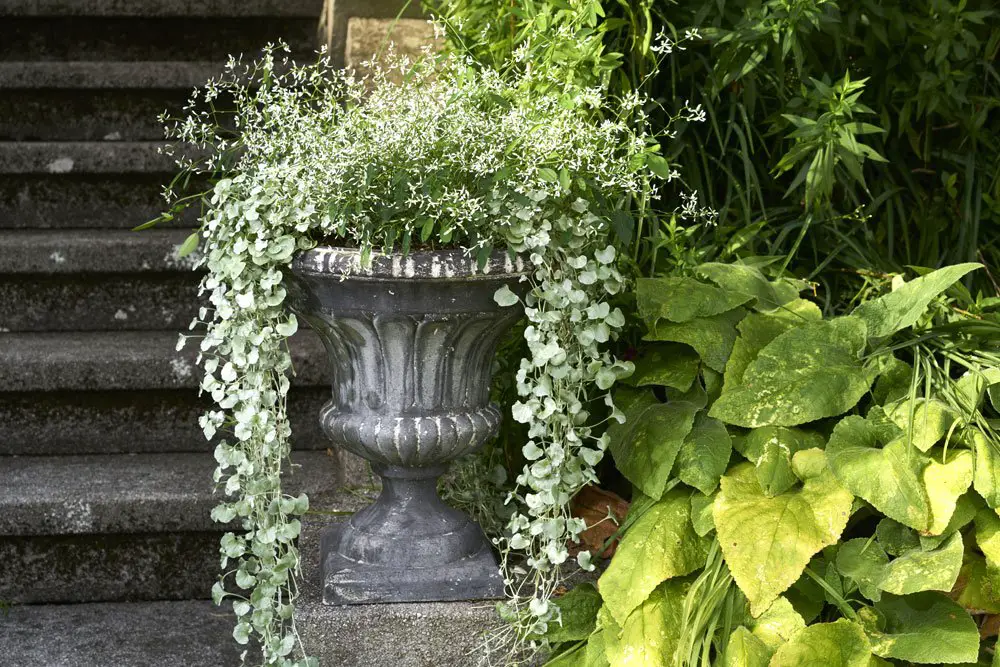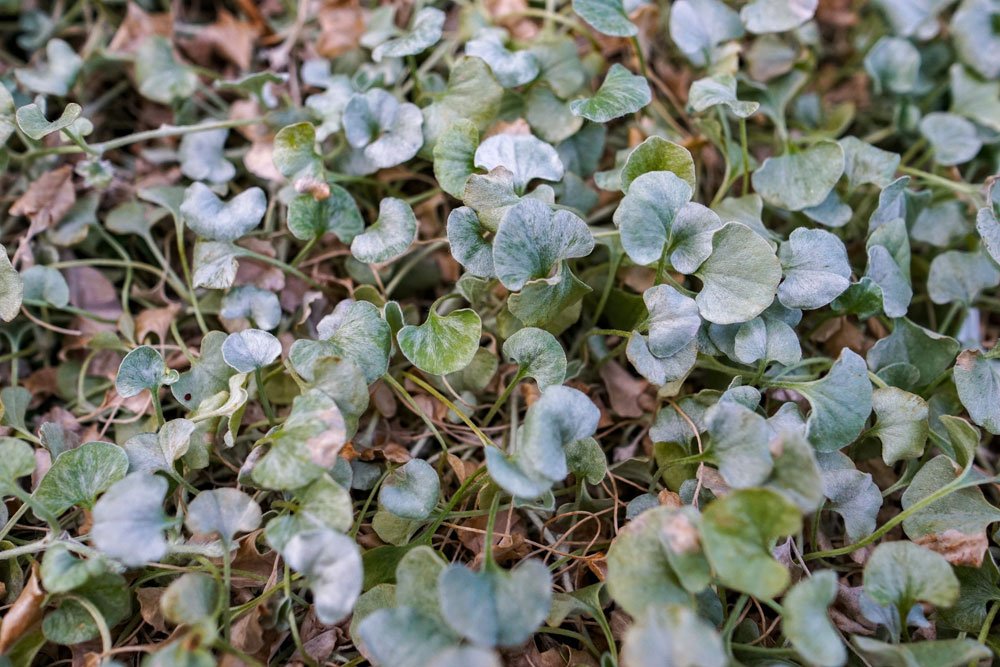
The exotic silver rain cuts a fine figure both as a ground cover and in a pot. If you overwinter it properly, it will last for several years.

The silver rain is an extremely attractive hanging plant. The rounded leaves appear like silver coins threaded on a string. In combination with colorful summer bloomers, the result is a high-contrast picture that is sure to be an eye-catcher. The silver rain can pour down up to two meters from the balcony. How this attractive plant is cultivated can be read below.
Contents [ show ]
Origin and distribution of silver rain
The hallmark of the silver rain is the silvery shimmering leaves, which can spread like a mat and form meter-long cords. In its natural habitat, the tropics and subtropics, the plant grows as a ground cover.
The silver rain is not an independent species, but is a particularly attractive breeding form of the Dichondra argentea, which is native to Central and South America. The genus Dichondra includes 15 species. Two forms are also native to Australia and New Zealand.
The silver rain belongs to the morning glory family and is therefore related to the sweet potato .
Tip: The sweet potato can also become an attractive hanging plant if half of the tuber is buried in potting soil.
Is silver rain poisonous?
Although the plants are not necessarily suitable for consumption, they are completely non-toxic to humans and animals.
In this context, it should be noted that there should be no confusion. Silberregen is the German common name for the common black locust. All parts of the plant are poisonous. Poisoning can lead to death in humans and animals.
Plant Silver Rain
Suitable location for the silver rain
A sunny and warm location is preferred. Temperatures must not fall below 16 degrees all year round. The plant knows how to help itself in shady locations and aligns its long shoots towards the sun. This is beneficial for balcony planting. While only the shoots are in the sun, the substrate in the pot needs to be watered less.
Tip: If the plant is too cold, growth will stop.
The silver rain should be protected from wind and rain. A particularly impressive picture emerges when the plant is associated with red-flowering perennials or summer flowers.
Ideal substrate for silver rain
The silver rain can be placed in conventional balcony potting soil. The plant is not picky about the right substrate. The only important thing is that it is loose soil with good permeability. The plants prefer to be too dry rather than too wet and are sensitive to waterlogging.
When planting in boxes and tubs, the risk of waterlogging is particularly high. Therefore, good drainage should not be missed. Excess irrigation water must not accumulate in the saucer but must be poured off immediately.
Prefer silver rain
Silver rain is available as a pot product ( for example from Blumen Eber ), but can also be grown from seeds. You can get these from existing plants, but you can also get them commercially.
#1 BESTSELLER
20 Dichondra repens Silver Falls Emerald Falls…
13,49 €
The seeds can be sown in plant pots filled with potting soil from mid-January. The planters are given a bright window seat and are placed at around 22 degrees.
Tip: The soil is only kept slightly moist and is best sprayed instead of watered.
A soil that is too moist leads to mold growth. Germination occurs after about two weeks. The ambient temperature can now be reduced to around 20 degrees.
Sowing can also be done directly outdoors. However, this will have to wait until May, as temperatures must not fall below 16 degrees.
You can cultivate the plant as a ground cover or as a hanging plant.
Planting silver rain as a ground cover – step by step

1. Select location
2. Prepare soil
3. Dig planting hole
4. Pay attention to distance
5. Insert plant
6. Fill substrate
7. Water plant
If the silver rain is to be planted in the bed as a ground cover, ensure a planting distance of at least 20 centimeters . The plants can spread more than half a meter.
Plant silver rain as a hanging plant – step by step
1. Select a planter
2. Prepare the substrate
3. Lay drainage
4. Fill in the substrate
5. Insert the plant
6. Fill the substrate
7. Press the soil lightly
8. Water the balcony box
The necessary planting distance must also be maintained in the balcony box. Up to four plants can be placed in a 50 centimeter long balcony box. It should be noted that the plants grow around 20 to 25 centimeters in height. In order to create an attractive overall appearance in the pot, you should choose taller companion plants.
Cultivate Silver Rain
Water silver rain correctly
The water requirement of the plants can be assessed as low. A dry and protected location should be chosen outdoors. Otherwise, in rainy summers, waterlogging can quickly occur. The plants in the bed only need to be watered if there is prolonged drought. You can wait until the soil has dried about two centimeters.
However, silver rain is usually cultivated in balcony boxes or planters. The water requirement is higher in a small space. The plants need regular watering. To prevent waterlogging, a drainage made of pottery shards or gravel must be created in the bottom of the vessel.
Fertilize silver rain properly
If the soil was enriched with mature compost or horn shavings before planting outdoors , an organic long-term fertilizer is provided and no additional fertilization needs to be carried out.
Fewer nutrients are available in boxes or buckets. Growth can therefore be promoted if a little liquid fertilizer is added to the irrigation water every two weeks.
OFFER#1 BESTSELLER
COMPO balcony and pot plant fertilizer for all…
Cut Silver Rain
In an ideal location, Silver Rain will grow lushly. If you give it free rein, the effect is even more impressive. If there is less space available, the shoots can be shortened at any time with sharp secateurs. This also offers the hobby gardener the opportunity to propagate the plant.
Multiply Silver Rain
Propagation can be done by sowing. The procedure has already been described.
However, there is a faster and simpler method: you can cut cuttings from existing plants and propagate them .
Proceed as follows:
1. Cut cuttings
2. Place cuttings in substrate
3. Place cuttings in a bright and protected place
4. Wait for rooting
Shoots about five centimeters long are suitable as cuttings. These are cut off or simply pinched off. The cuttings are immediately placed in plant pots filled with potting soil. A bright location but protected from the blazing midday sun is ideal. The cuttings root within a short time. Successful propagation can be recognized by the new leaves sprouting. Once the plants are rooted, you can move them into boxes and pots or plant them outdoors.
Overwinter silver rain
In our latitudes, the exotic is usually cultivated as an annual plant and disposed of in beds or buckets after the summer. This is not necessary because the plants can be overwintered quite easily.
The winter quarters should be bright and the temperature must not fall below ten degrees. Otherwise, the plants will extend their rest period and stop growing completely. This is not beneficial for lush growth next season.
In winter the silver rain is only watered sporadically. In spring the plant is cut back and begins to sprout again. Now it is watered regularly again. Once the danger of frost has passed in mid-May, the plants can go back outdoors.
